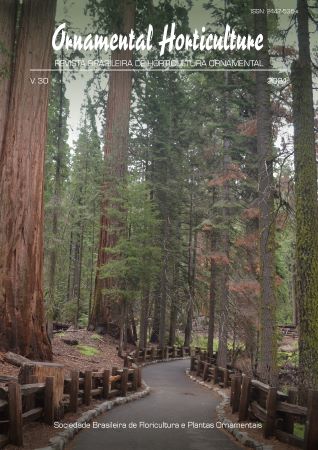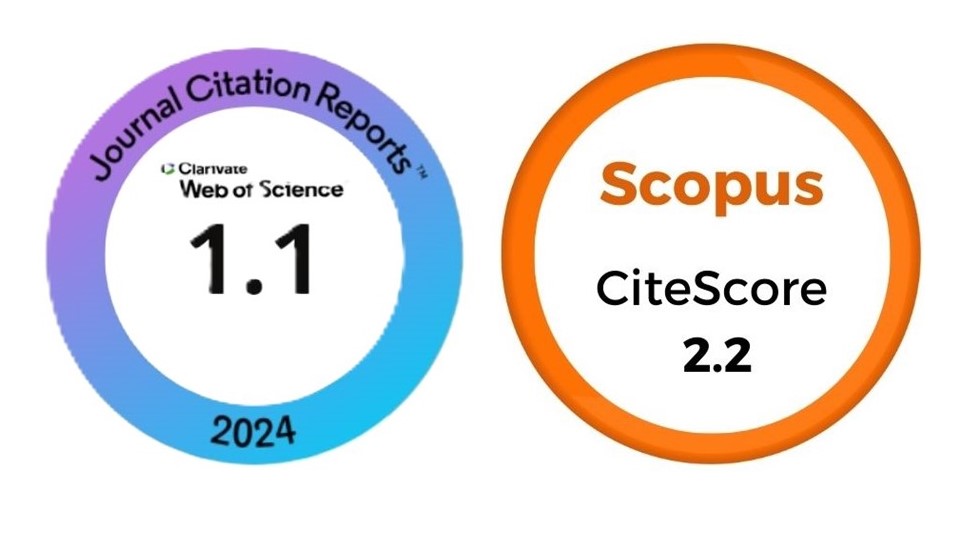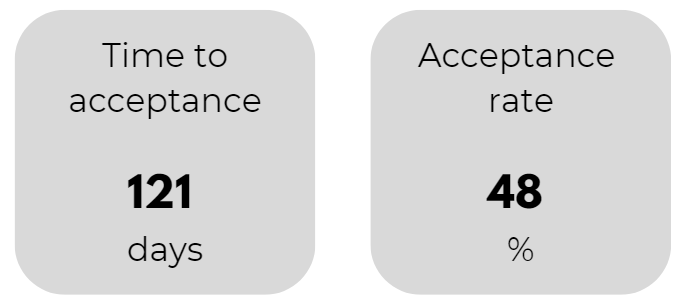Potencializando o florescimento e crescimento vegetativo em Oncidium baueri Lindl. com a aplicação de ácido giberélico: aspectos fisiológicos em destaque
DOI:
https://doi.org/10.1590/2447-536X.v30.e242783Palavras-chave:
fisiologia, giberelina, hormônio vegetal, OrchidaceaeResumo
Reguladores vegetais são alvos de estudos por terem a capacidade de modificar aspectos de interesse comercial nas plantas. É o caso do ácido giberélico (AG3), um dos hormônios responsáveis pelo crescimento e que está envolvido no processo de floração de muitos vegetais. Dessa maneira, o presente estudo buscou verificar os efeitos causados pela aplicação exógena de diferentes doses do regulador vegetal AG3 nos padrões florais,
vegetativos e fisiológicos da orquídea Oncidium baueri. Os tratamentos experimentais (T1; T2; T3; T4; e T5) tiveram 10 repetições, cada uma contendo uma planta, com as respectivas doses pulverizadas: 0, 50, 100, 200 e 400 mg L-1 de AG3. Os parâmetros mensurados foram: comprimento (CP) e largura de pseudobulbo (LP), comprimento e largura de folhas (CF e LF), número de folhas por planta (NF), tempo para emissão de hastes florais (TEHF), tempo para abertura total (TATF) e tempo de queda de flores (TQF), com período mensurado em dias. O tamanho de haste floral (THF), o número de flores por haste (NFH), fluorescência da clorofila a (fv/fm) e a condutância estomática (Gs) também foram mensurados. A concentração de 200 mg L-1 de AG3 incrementou 3 cm na média em CP, CF. O NF apresentou tendência de aumento com o tratamento 4 em relação às doses diferentes de 0 mg L-1. Para os aspectos florais a mesma dose apresentou menor TEHF, sendo o único em destaque dentre os demais tratamentos. Para os parâmetros fisiológicos, essa mesma dose respondeu com maior valor de fv/fm (0,826) e Gs (65,340 mmol m-2 s-1). Dessa maneira o uso de 200 mg L-1 de AG3 é recomendado em plantas de O. baueri para otimização da promoção vegetativa e floral.
Downloads
Referências
AHMAD, S.; PENG, D.; ZHOU, Y.; ZHAO, K. The genetic and hormonal inducers of continuous flowering in orchids: An emerging view. Cells, v.11, n.4, p.1-17, 2022a. https://doi.org/10.3390/cells11040657
AHMAD, S.; YANG, K.; CHEN, G.; HUANG, J.; HAO, Y.; TU, S.; PENG, D. Transcriptome mining of hormonal and floral integrators in the leafless flowers of three cymbidium orchids. Frontiers in Plant Science, v.13, p.1043099, 2022b. https://doi.org/10.3389/fpls.2022.1043099
BOX, G.E.; COX, D.R. An analysis of transformations. Journal of the Royal Statistical Society: Series B (Methodological), v.26, n.2, p.211-243, 1964.
BRAINER, M.S.C.P. Flores e plantas ornamentais. Cadernos setorial ETENE n.95. Fortaleza: Banco do Brasil, 2019.
DE PAULA, J.C.B.; GUARIZ, H.R.; DE MORAES, K.A.M.; SHIMIZU, G.D.; DE FARIA, R.T.; DE OLIVEIRA, H.C.; FRACETO, L.F.; SANTO PEREIRA, A.E. Enhanced germination of seeds native to Brazil: A comparative analysis between free and nanoencapsulated gibberellic acid in Dyckia sp. (Bromeliaceae). Folia Horticulturae, v.35, n.2, p.1-16, 2023. https://doi.org/10.2478/fhort-2023-0029
ENDRES, D.; SASAMORI, M.H.; SCHMITT, J.L.; DROSTE, A. Survival and development of reintroduced Cattleya intermedia plants related to abiotic factors and herbivory at the edge and in the interior of a forest fragment in South Brazil. Acta Botanica Brasilica, v.32, n.4, p.555-566, 2018. https://doi.org/10.1590/0102-33062018abb0009
FARIA, R.T.D.; COLOMBO, R.C. Oncidium: the expanding orchid in the flowering scene. Horticultura Brasileira, v.33, n.4, p.533-533, 2015. https://doi.org/10.1590/S0102-053620150000400022
GUARIZ, H.R.; SHIMIZU, G.D.; PAULA, J.C.; SPERANDIO, H.V.; RIBEIRO JUNIOR, W.A.; OLIVEIRA, H.C.; JUSSIANI, E.I.; ANDRELLO, A.C.; MARUBAYASHI, R.Y.P.; PICOLI, M.H.S.; RUEDIGER, J.; COUTO, A.P.S.; MORAES, K.A.. Anatomy and Germination of Erythrina velutina Seeds under a different imbibition period in gibberellin. Seeds, v.1, n.3, p.210-220, 2022. https://doi.org/10.3390/seeds1030018
HUANG, J.Z.; VILLEGAS, P.B.; CHEN, F.C. Regulation of flowering in orchids. In: CHEN, F.C.; CHIN, S.W. The Orchid Genome. Compendium of Plant Genomes. Cham: Springer, 2021. p.73-94. https://doi.org/10.1007/978-3-030-66826-6_6
IBRAFLOR (Instituto Brasileiro de Floricultura). O mercado de flores no brasil (01/2024). Available at: <https://www.ibraflor.com.br/_files/ugd/5 bcab9_1de516ce08144d058bd8167c5db12ca8.pdf. Accessed on: August 19th, 2024.
ILLOUZ-ELIAZ, N.; NISSAN, I.; NIR, I.; RAMON, U.; SHOHAT, H.; WEISS, D. Mutations in the tomato gibberellin receptors suppress xylem proliferation and reduce water loss under water-deficit conditions. Journal of Experimental Botany, v.71, n.12, p.3603-3612, 2020. https://doi.org/10.1093/jxb/eraa137
KHAIRUL-ANUAR, M.A.; MAZUMDAR, P.; LUM, S.; HARIKRISHNA, J.A. Dendrobium hybrid flower number and pedicel curvature is influenced by the application of gibberellic acid and indole-3-acetic acid. Biology Bulletin, v.48, n.6, p.740-745, 2021. https://doi.org/10.1134/S1062359021130057
KHANDAKER, M.M.; MAJRASHI, A.; BOYCE, A.N. The influence of gibberellic acid on the chlorophyll fluorescence, protein content and PAL activity of wax apple (Syzygium samarangense var. jambu madu) fruits. Australian Journal of Crop Science, v.9, n.12, p.1221-1227, 2015. https://search.informit.org/doi/abs/10.3316/informit.769396779143664.
LAKSHMAIAH, K.; SUBRAMANIAN, S.; GANGA, M.; JEYAKUMAR, P. Optimization of pinching and GA3 application to improve growth and flowering of lisianthus (Eustoma grandiflorum). Journal of Pharmacognosy and Phytochemistry, v.8, n.6, p.614-616, 2019.
LEE, H.B.; IM, N.H.; AN, S.K.; KIM, K.S. Changes of growth and inflorescence initiation by exogenous gibberellic acid3 and 6-benzylaminopurine application in Phalaenopsis Orchids. Agronomy, v.11, n.2, p.1-10, 2021. https://doi.org/10.3390/agronomy11020196
LI, W.; XIANG, F.; SU, Y.; LUO, Z.; LUO, W.; ZHOU, L.; XIAO, L. Gibberellin increases the bud yield and theanine accumulation in Camellia sinensis (L.) Kuntze. Molecules, v.26, n.11, p.1-14, 2021. https://doi.org/10.3390/molecules26113290
MENEGAES, J.F.; FERREIRA, C.F.; MOCCELLIN, R. Plantas ornamentais: conceitos básicos de cultivo. Nova Xavantina: Pantanal Editora, 2022. 144p. https://doi.org/10.46420/9786581460549
MEZZALIRA, F.K.; KUHN, B.C. 2021. Padronização de um protocolo para assepsia de segmentos nodais de Phalaenopsis para clonagem in vitro. Colloquium Agrariae, v.17, n.1. p.10-17, 2021. https://doi.org/10.5747/ca.2021.v17.n1.a415
NADAL, M.C.; ASSIS, A.M.; SCHUCH, M.W.; FARIA, R.T. Grape-based residue as a substrate in Oncidium baueri Lindl. acclimatization. Ornamental Horticulture, v.28, n.2, p.239-245, 2022. https://doi.org/10.1590/2447-536X.v28i2.2477
NUNES, E.L.; PELUZIO, L.E.; PERUSSO, G.; CARVALHO, T.S. Monitoramento ambiental de área controlada para produção de orquídeas: caracterização sazonal das variáveis climáticas. Revista Ponto de Vista, v.9, n.2, p.37-53, 2020. https://doi.org/10.47328/rpv.v9i02.10822.
ORDOÑEZ-HERRERA, N.; TRIMBORN, L.; MENJE, M.; HENSCHEL, M.; ROBERS, L.; KAUFHOLDT, D.; HOECKER, U. The transcription factor COL12 is a substrate of the COP1/SPA E3 ligase and regulates flowering time and plant architecture. Plant Physiology, v.176, n.2, p.1327-1340, 2018. https://doi.org/10.1104/pp.17.01207
PAIXÃO, M.V.S.; GROBÉRIO, R.B.C.; HOFFAY, A.C.N.; CORREA, A.C.; CREMONINI, G.M. Ácido giberélico na germinação de sementes e desenvolvimento inicial de plântulas de mamoeiro. Agrotrópica, v.33, n.2, p.143-148, 2021. https://doi.org/10.21757/0103-3816.2021v33n2p143-148
PEIXOTO, P.H.P.; PIMENTA, M.R.; REIS, L.B. Fisiologia Vegetal: Uma abordagem prática em multimídia. Juiz de Fora: Instituto de Ciências Biológicas, 2024. 88p.
R CORE TEAM. R: A language and environment for statistical computing. R Foundation for Statistical Computing, 2024. Available from: <https://www.R-project.org>.
REFLORA. Orchidaceae in Flora e Funga do Brasil. Rio de Janeiro: Jardim Botânico do Rio de Janeiro, 2024. Available from: https://floradobrasil.jbrj.gov.br/FB179. Accessed: feb. 10, 2024.
RIEGER, M.M. Surfactants. In: LIEBERMAN, H.; RIEGER, M.; BANKER, G.S. Pharmaceutical Dosage Forms. New York: CRC Press., 2020. p.211-286.
SHIMIZU, M.; ISHIDA, A.; TANGE, T.; YAGI, H. Leaf turnover and growth responses of shade-grown saplings of four Shorea rain forest species to a sudden increase in light. Tree physiology, v.26, n.4, p.449-457, 2006. https://doi.org/10.1093/treephys/26.4.449
SILVEIRA, E.V.; STEFANELLO, S. Growth and Flowering of Miltonia flavescens LINDL. plants. (ORCHIDACEAE) treated with Giberellic acid. Revista em Agronegócio e Meio Ambiente, v.6, n.2, 2013. https://doi.org/10.17765/2176-9168.2013v6n2p%25p
TEJEDA-SARTORIUS, O.; SOTO-HERNÁNDEZ, R.M.; SAN MIGUEL-CHÁVEZ, R.; TREJO-TÉLLEZ, L.I.; CAAMAL-VELÁZQUEZ, H. Endogenous hormone profile and sugars display differential distribution in leaves and pseudobulbs of Laelia anceps plants induced and non-induced to flowering by exogenous gibberellic acid. Plants, v.11, n.7, p.845, 2022. https://doi.org/10.3390/plants11070845
TEJEDA-SARTORIUS, O.; VAQUERA-HUERTA, H.; TREJO-TÉLLEZ, L.I.; SOTO-HERNÁNDEZ, R.M.; SÁNCHEZ-ESCUDERO, J. Gibberellic acid and 6-benzyladenine reduce time to flowering and improve flower quality of Laelia anceps. Folia Horticulturae, v.33, n.1, p.121-133, 2021. https://doi.org/10.2478/fhort-2021-0009
VERDOLIN, L.G.; MARIZ, M.L.; DIAS, L.L.C. Gibberellin and polyamines effects in growth and flowering of New Guinea impatiens. Ornamental Horticulturae, v.27, n.2, p.247-254, 2021. https://doi.org/10.1590/2447-536X.v27i2.2255
WANG, S.L.; VISWANATH, K.K.; TONG, C.G.; AN, H.R., JANG, S.; CHEN, F.C. Floral induction and flower development of orchids. Frontiers in Plant Science, v.10, n.1258, p.1-15, 2019. https://doi.org/10.3389/fpls.2019.01258
WCSP (WORLD CHECKLIST OF SELECTED PLANTS FAMILIES). Ochidaceae, 2019. Royal Botanic Gardens, Kew. Available at: < https://powo.science.kew.org/>. Accessed on: Feb. 10, 2024.
World Flora Online – WFO. (2024). Published on the Internet; Available at: http://www.worldfloraonline.org. Accessed on: 10 de jan. de 2024.
Downloads
Publicado
Edição
Seção
Licença
Copyright (c) 2024 Ornamental Horticulture

Este trabalho está licenciado sob uma licença Creative Commons Attribution 4.0 International License.








